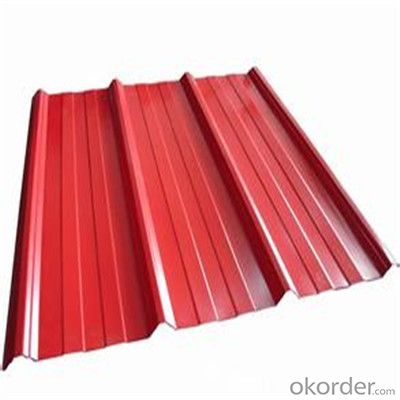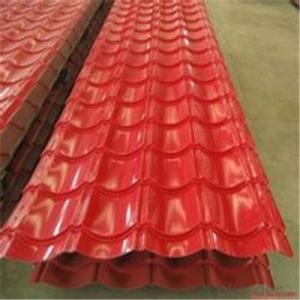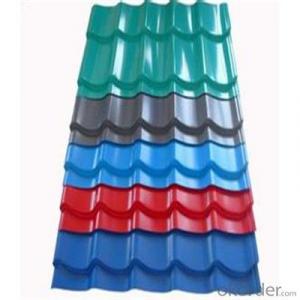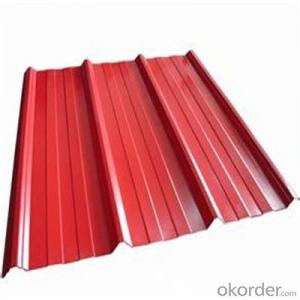Zinc Coating Galvanized Corrugated Steel Iron Zinc Roof Sheet
- Loading Port:
- Shanghai
- Payment Terms:
- TT OR LC
- Min Order Qty:
- 200 m.t.
- Supply Capability:
- 1000000 m.t./month
OKorder Service Pledge
OKorder Financial Service
You Might Also Like
Item specifice
Description of Corrugated Iron Sheet:
1) Capacity: about 15,000 tons per month for sheet product.
2) Standard: JIS G3302 1998, ASTM A653M/A924M 2004, all according to the customer's request
3) Thickness: 0.13mm-0.5mm
4) Width: 400mm-1000mm
5) Length: We can adjust the length according to your request
6) Zinc Coating Weight: 60g/m2-275g/m2
Specifications of Corrugated Iron Sheet:
Standards: GB, JIS3312 and ASTM
Materials: SGCC, Q195-Q235B, SPCC, DC01, DX51D+Z and more
Thicknesses: 0.23-1.0MM
Widths: 600-1200mm
Zinc coating: 80 to 275g/m²
Features of Corrugated Iron Sheet:
Spangle: Regular spangle, minimized spangle and zero spangle
Hardness: Full hard, normal
Color: RAL, or other series
Surface Protection: PE, PVC, PVDF, SMP, HDP, etc.
Min trial order 10 tons each thickness, 1x20' per delivery.
Images of Corrugated Iron Sheet:

FAQ:
1. What's the Delivery port?
The main ports are Qingdao and Tianjin, we also can deliver to other ports to meet your requirements
2. How long is the lead time?
Delivery time: 45 days after order confirmed.
3. What payment term do you accept?
Payment: T/T or L/C at sight.
- Q:How are steel sheets coated for corrosion resistance?
- Steel sheets are typically coated for corrosion resistance through various methods such as hot-dip galvanizing, electroplating, or applying organic coatings like paints or powder coatings.
- Q:What are the different types of coatings available for steel sheets?
- There are several types of coatings available for steel sheets, including galvanized coatings, zinc coatings, tin coatings, aluminum coatings, and polymer coatings. Each type of coating offers unique properties and benefits, such as corrosion resistance, improved durability, enhanced aesthetics, and increased protection against environmental factors. The choice of coating depends on the specific application and desired characteristics of the steel sheets.
- Q:Can steel sheets be painted after installation?
- Yes, steel sheets can be painted after installation. The paint can adhere to the surface of the steel sheets, providing protection against corrosion and enhancing their appearance.
- Q:Stainless steel plate and steel welding
- It is better to use argon arc welding or white steel welding rod, with electrode generally 3.2 or 2.5 can be, the color will change with some, wipe it will be good.
- Q:What is the difference between a smooth and textured steel sheet?
- The surface appearance and feel of a smooth steel sheet and a textured steel sheet are what primarily distinguish them. A smooth steel sheet boasts a flat and flawless surface without any visible patterns or textures. Its sleek and polished look makes it suitable for applications where aesthetics play a crucial role, such as architectural designs, interior decoration, or automotive body parts. On the contrary, a textured steel sheet is deliberately manipulated to create patterns or textures on its surface. These patterns can vary from simple lines or ridges to more intricate designs like diamond or checker plate patterns. The textured surface adds visual interest and can also enhance the sheet's functionality by providing improved grip or traction. The choice between a smooth and textured steel sheet depends on the intended use and desired outcome. Smooth steel sheets are commonly used in applications where a clean and polished appearance is desired, such as in high-end appliances or furniture. They are also frequently employed in industries where a smooth surface is essential for efficient processes, like food processing or packaging. Textured steel sheets, on the other hand, are preferred in applications where both functionality and aesthetics are important. For instance, they are frequently utilized in flooring or stairs because the textured surface provides additional grip and reduces the risk of slipping. These sheets are also commonly found in truck beds, ramps, or walkways where enhanced traction is necessary. In conclusion, the primary difference between a smooth and textured steel sheet lies in their surface appearance and functionality. Smooth steel sheets offer a sleek and flawless look, while textured steel sheets showcase intentional patterns or textures that can enhance grip, traction, and visual interest. The choice between the two depends on the specific requirements of the application and the desired outcome.
- Q:Can steel sheets be used for roofing purposes?
- Yes, steel sheets can be used for roofing purposes. Steel is a durable and long-lasting material that is resistant to corrosion, making it an excellent choice for roofing. Steel sheets provide strength and stability to the roof, protecting the building from various weather conditions. Additionally, steel roofs are low maintenance and can be energy-efficient if properly insulated.
- Q:Are steel sheets vulnerable to UV radiation?
- Steel sheets are generally not vulnerable to UV radiation. This is because steel is a highly durable and resilient material that is resistant to many environmental factors, including UV radiation. Unlike some other materials, steel does not become weakened or degraded when exposed to prolonged sunlight or UV rays. In fact, many steel structures, such as buildings, bridges, and outdoor equipment, are designed to withstand outdoor conditions and can last for several decades without significant damage from UV radiation. However, it is important to note that certain types of steel, such as galvanized steel, may be more resistant to UV radiation due to additional protective coatings applied during the manufacturing process. Overall, steel sheets are a reliable choice for applications that require resistance to UV radiation.
- Q:Can the steel sheets be used for decorative purposes?
- Certainly, decorative purposes can be fulfilled by steel sheets. Customization and shaping of steel sheets into an array of designs, patterns, and sizes enable their suitability for diverse decorative applications. They are ideal for crafting distinctive and contemporary architectural elements like ornamental facades, decorative wall panels, or intricate metal screens. Moreover, steel sheets find utility in decorative furniture, art installations, and sculptures. Their popularity stems from their versatility, durability, and sleek appearance, which effortlessly infuse spaces with elegance and sophistication, both indoors and outdoors.
- Q:What is the shelf life of steel sheets?
- Steel sheets are typically believed to have an indefinite shelf life. Unlike perishable items, steel sheets lack an expiration date or limited lifespan. If stored and maintained properly, steel sheets can maintain their good condition for numerous years, if not decades, without significant deterioration. However, exposure to certain environmental elements like moisture, extreme temperatures, and corrosive substances can impact the quality and durability of steel sheets over time. Hence, it is advisable to store steel sheets in a controlled and dry setting to guarantee their longevity and avert any potential harm or decline.
- Q:Can steel sheets be perforated for ventilation purposes?
- Yes, steel sheets can be perforated for ventilation purposes. Perforated steel sheets are commonly used in various industries and applications where ventilation is required. The perforations in the steel sheets allow for the passage of air while still maintaining the structural integrity of the material. These perforations can be customized to meet specific ventilation requirements, such as the size and pattern of the holes. Perforated steel sheets are often used in HVAC systems, industrial equipment, architectural projects, and acoustic panels, among others, where a balance between ventilation and strength is necessary.
1. Manufacturer Overview |
|
|---|---|
| Location | |
| Year Established | |
| Annual Output Value | |
| Main Markets | |
| Company Certifications | |
2. Manufacturer Certificates |
|
|---|---|
| a) Certification Name | |
| Range | |
| Reference | |
| Validity Period | |
3. Manufacturer Capability |
|
|---|---|
| a)Trade Capacity | |
| Nearest Port | |
| Export Percentage | |
| No.of Employees in Trade Department | |
| Language Spoken: | |
| b)Factory Information | |
| Factory Size: | |
| No. of Production Lines | |
| Contract Manufacturing | |
| Product Price Range | |
Send your message to us
Zinc Coating Galvanized Corrugated Steel Iron Zinc Roof Sheet
- Loading Port:
- Shanghai
- Payment Terms:
- TT OR LC
- Min Order Qty:
- 200 m.t.
- Supply Capability:
- 1000000 m.t./month
OKorder Service Pledge
OKorder Financial Service
Similar products
New products
Hot products
Related keywords






























